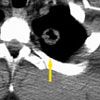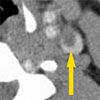- Clinical Technology
- Adult Immunization
- Hepatology
- Pediatric Immunization
- Screening
- Psychiatry
- Allergy
- Women's Health
- Cardiology
- Pediatrics
- Dermatology
- Endocrinology
- Pain Management
- Gastroenterology
- Infectious Disease
- Obesity Medicine
- Rheumatology
- Nephrology
- Neurology
- Pulmonology
Lemierre Syndrome
A previously healthy 21-year-old man presented with high fever, cough, and pleuritic chest pain. His illness began 6 days earlier with a sore throat that was followed by worsening dyspnea.
A previously healthy 21-year-old man presented with high fever, cough, and pleuritic chest pain. His illness began 6 days earlier with a sore throat that was followed by worsening dyspnea.
The patient appeared to be acutely ill. He was febrile (temperature, 39.3°C [102.7°F]); tachypneic, with an oxygen saturation of 90% via nasal cannula despite 6 L of oxygen; and tachycardic but normotensive. The oropharynx appeared normal. Breath sounds were decreased in the right lung base. Abdomen and extremities were normal.
Chest radiographic findings were consistent with right lower lobe pneumonia. The patient was hospitalized, and therapy with intravenous ceftriaxone and azithromycin for community-acquired pneumonia was started.
The white blood cell count was 10,000/µL; there was mild thrombocytopenia (platelet count, 111,000/µL); prothrombin and partial thromboplastin times were normal. Transaminase levels were elevated to twice the upper limit of normal.

On day 2 of hospitalization, the patient's temperature remained high despite treatment, and bilateral empyema developed that required chest tube insertion.
A CT scan of the lung apices revealed an inflammatory mass with an air signal, which was consistent with an abscess cavity (Figure 1). Blood cultures grew Fusobacterium necrophorum. The antibiotic regimen was switched to intravenous ticarcillin/clavulanate and clindamycin.
Suppurative jugular venous thrombosis with emboli to the lungs, or Lemierre syndrome, was suspected based on the lung abscess, anaerobic septicemia, and sore throat prodrome. A CT scan of the neck demonstrated a filling defect of the jugular vein, which confirmed the diagnosis (Figure 2).

The patient's fever abated after 5 days of treatment. After 6 weeks, the neck thrombus and pulmonary abscess had completely resolved.
LEMIERRE SYNDROME: AN OVERVIEW
Lemierre syndrome, also known as postanginal sepsis and necrobacillosis, was first described in 1936. In the preantibiotic era, mortality was 90%1; with the advent of antibiotics, it has fallen to about 6%, which is still significant given that affected patients are usually young and otherwise healthy.2
Lemierre syndrome classically presents as an acute illness, with high fever, rigors, severe prostration, and respiratory distress. Neck pain or tenderness and exudative tonsillitis are present in about half of patients; however, these symptoms may be absent at the time of presentation, as was the case in this patient.2
The syndrome appears to result from the extension of the tonsillar infection into the lateral pharyngeal space, which leads to suppurative thrombophlebitis in about 70% of patients and metastatic spread to the lungs in about 80% of patients.2 Lung abscesses and empyema are common complications. Thrombocytopenia occurs for unclear reasons.
Diagnosis. The diagnosis of Lemierre syndrome requires a high degree of suspicion. Be alert for suppurative jugular thrombosis in patients who have sepsis with pulmonary emboli, especially when an anaerobic bacterium is detected in blood cultures or symptoms are preceded by sore throat or unilateral neck pain. Lemierre syndrome is usually caused by anaerobic bacteria in the normal oral flora; F necrophorum is the most common causative organism (in 81.7% cases).2 The diagnosis can be confirmed with a CT or MRI scan of the neck that shows a filling defect in the affected vein.
Treatment. Intravenous antibiotics with β-lactamase resistance are recommended for at least 4 weeks or until the lung abscesses and thrombus resolve. Anticoagulation therapy is generally not recommended unless the patient has retrograde clot propagation.3 Ligation of the internal jugular vein may be needed in patients who have persistent sepsis despite treatment, although this is rare.2
References:
REFERENCES:
1.
Lemierre A. On certain septicemias due to anaerobic organisms. Lancet. 1936;1:701-703.
2.
Chirinos JA, Lichtstein DM, Garcia J, Tamariz LJ. The evolution of Lemierre syndrome: a report of 2 cases and a review of the literature. Medicine (Baltimore). 2002;81:458-465.
3.
Lustig LR, Cusick BC, Cheung SW, Lee KC. Lemierre's syndrome: two cases of postanginal sepsis. Otolaryngol Head Neck Surg. 1995;112:767-772.
